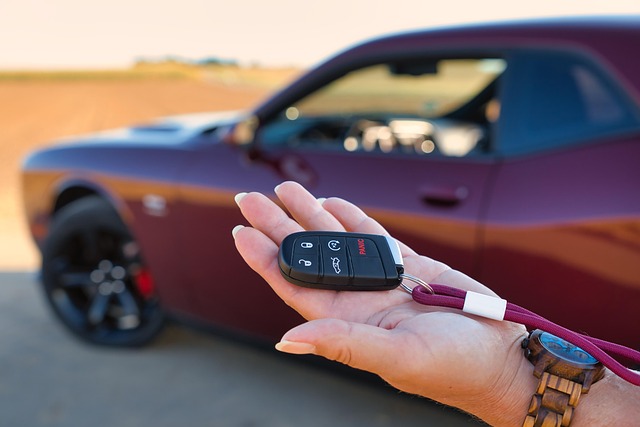Looking to register your car in California? Our step-by-step guide helps you navigate the process efficiently. From understanding crucial registration requirements to completing essential DMV tasks, we cover it all. Begin by gathering necessary documents and preparing for a successful visit. Next, perform a DMV (Department of Motor Vehicles) vin verification using your Vehicle Identification Number (VIN). After that, fill out applications, pay fees, receive your license plate, and finally, register your vehicle online.
- Understand California Car Registration Requirements
- Gather Necessary Documents for DMV Visit
- Perform Vehicle Identification Number (VIN) Verification
- Complete Application and Pay Fees at DMV
- Receive License Plate and Register Your Vehicle Online
Understand California Car Registration Requirements

Before registering your car in California, it’s crucial to understand the state’s specific requirements. The California Department of Motor Vehicles (DMV) mandates several steps for new and used vehicle registrations, including a thorough inspection known as a vin inspection. This process involves verifying the vehicle identification number (VIN) to ensure its authenticity and history. A mobile vin verifier or mobile vin verification service can simplify this step by providing on-site VIN checking, making it easier for owners to meet DMV standards.
During registration, you’ll need to present valid documentation such as proof of ownership, vehicle title, current insurance, and a valid driver’s license. Additionally, the DMV requires a completed application form and relevant fees. A vin inspection is typically conducted to ensure the car matches the provided VIN and to check for any outstanding issues or recalls. By understanding these requirements beforehand, you can streamline the registration process and avoid potential delays.
Gather Necessary Documents for DMV Visit

Before visiting your local California DMV office, make sure to gather all the essential documents required for car registration. This process is crucial and involves several key steps. Firstly, obtain your vehicle’s Registration Application (Form DV-140), which you can download from the DMV website or pick up in person. You’ll also need proof of identity, such as a driver’s license or state ID card, and proof of residency, like a utility bill or lease agreement.
Additionally, the Department of Motor Vehicles (DMV) will require a valid Vehicle Identification Number (VIN) inspection report. This can be completed through a mobile VIN inspection service, which allows you to get the necessary verification from the comfort of your home. Alternatively, many automotive businesses and some DMV locations offer on-site VIN inspections. Ensure that all documents are up-to-date and accurate to streamline the registration process.
Perform Vehicle Identification Number (VIN) Verification

Before registering your car in California, it’s crucial to perform a Vehicle Identification Number (VIN) verification. This step is essential as it ensures that the vehicle you’re about to register is genuine and has not been reported stolen or had its identity altered. The California Department of Motor Vehicles (DMV) recommends this process, which involves cross-referencing the VIN with reputable databases to confirm its history.
A mobile VIN inspection or verifier can be particularly useful for this task. These services allow you to have the verification done conveniently at your location. By employing a mobile vin inspector, you can save time and effort compared to visiting a DMV office. They use advanced technology to swiftly access and validate the vehicle’s information, providing peace of mind that your car is safe and legal to register in California.
Complete Application and Pay Fees at DMV

To register your car in California, the first step is to complete the Application for Title and Registration (Form DV367). This form requires detailed information about your vehicle, including its make, model, year, and unique Vehicle Identification Number (VIN). Alongside this, you’ll need to provide proof of insurance, a completed odometer reading, and any applicable fees.
Once your application is complete, it’s time to visit or contact the California Department of Motor Vehicles (DMV) office for vin verification. This includes paying the necessary registration fees. For convenience, many DMV locations offer mobile vin inspection services, allowing you to verify your car’s VIN without having to visit a physical office. You can also opt for a third-party service, such as a mobile vin inspection, if preferred.
Receive License Plate and Register Your Vehicle Online

After completing your vehicle purchase in California, it’s time to register your car with the Department of Motor Vehicles (DMV). Before registering, you’ll need to undergo a DMV vin verification process to ensure the vehicle’s history is clean and there are no outstanding issues. This can be done online through the official DMV website, making the process convenient and efficient.
One option for a seamless experience is utilizing a mobile vin verifier service. These services allow you to complete the vin inspection digitally, providing real-time results. Simply enter your vehicle’s unique identification number (VIN) into the mobile app or platform, which will access the car’s history data from various databases. This technology streamlines the registration process and helps ensure that your new California plate is issued correctly and promptly.
Registering a car in California involves understanding clear requirements, gathering essential documents, and completing a straightforward process. After performing a mandatory DMV VIN verification to ensure vehicle authenticity, you can fill out applications and pay fees at your local DMV. Upon approval, you’ll receive license plates and finalize the registration online, ensuring your vehicle is legally compliant in the Golden State.
